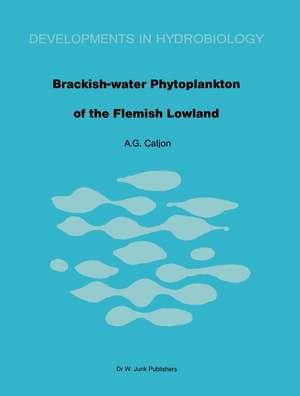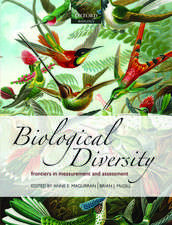Brackish-water phytoplankton of the Flemish lowland: Developments in Hydrobiology, cartea 18
Autor A.G. Caljonen Limba Engleză Paperback – 19 oct 2011
| Toate formatele și edițiile | Preț | Express |
|---|---|---|
| Paperback (1) | 952.57 lei 6-8 săpt. | |
| SPRINGER NETHERLANDS – 19 oct 2011 | 952.57 lei 6-8 săpt. | |
| Hardback (1) | 1212.68 lei 38-44 zile | |
| SPRINGER NETHERLANDS – 31 ian 1984 | 1212.68 lei 38-44 zile |
Din seria Developments in Hydrobiology
- 18%
 Preț: 1229.10 lei
Preț: 1229.10 lei - 18%
 Preț: 959.98 lei
Preț: 959.98 lei - 18%
 Preț: 963.91 lei
Preț: 963.91 lei - 15%
 Preț: 648.24 lei
Preț: 648.24 lei - 15%
 Preț: 637.89 lei
Preț: 637.89 lei -
 Preț: 378.25 lei
Preț: 378.25 lei - 15%
 Preț: 644.95 lei
Preț: 644.95 lei - 18%
 Preț: 952.09 lei
Preț: 952.09 lei - 20%
 Preț: 558.87 lei
Preț: 558.87 lei - 18%
 Preț: 1833.65 lei
Preț: 1833.65 lei -
 Preț: 393.59 lei
Preț: 393.59 lei -
 Preț: 406.54 lei
Preț: 406.54 lei - 18%
 Preț: 1226.73 lei
Preț: 1226.73 lei - 18%
 Preț: 956.99 lei
Preț: 956.99 lei -
 Preț: 388.87 lei
Preț: 388.87 lei - 24%
 Preț: 1060.53 lei
Preț: 1060.53 lei - 18%
 Preț: 1229.28 lei
Preț: 1229.28 lei - 20%
 Preț: 569.31 lei
Preț: 569.31 lei -
 Preț: 368.79 lei
Preț: 368.79 lei - 24%
 Preț: 817.48 lei
Preț: 817.48 lei - 18%
 Preț: 958.25 lei
Preț: 958.25 lei - 18%
 Preț: 953.03 lei
Preț: 953.03 lei -
 Preț: 384.75 lei
Preț: 384.75 lei - 24%
 Preț: 1582.95 lei
Preț: 1582.95 lei - 24%
 Preț: 1051.70 lei
Preț: 1051.70 lei - 18%
 Preț: 943.57 lei
Preț: 943.57 lei - 18%
 Preț: 1235.76 lei
Preț: 1235.76 lei - 24%
 Preț: 800.05 lei
Preț: 800.05 lei - 24%
 Preț: 803.57 lei
Preț: 803.57 lei - 18%
 Preț: 948.29 lei
Preț: 948.29 lei
Preț: 952.57 lei
Preț vechi: 1161.67 lei
-18% Nou
Puncte Express: 1429
Preț estimativ în valută:
182.27€ • 198.61$ • 153.59£
182.27€ • 198.61$ • 153.59£
Carte tipărită la comandă
Livrare economică 23 aprilie-07 mai
Preluare comenzi: 021 569.72.76
Specificații
ISBN-13: 9789400965560
ISBN-10: 9400965567
Pagini: 284
Ilustrații: VIII, 272 p. 47 illus.
Dimensiuni: 210 x 279 x 15 mm
Greutate: 0.65 kg
Ediția:1983
Editura: SPRINGER NETHERLANDS
Colecția Springer
Seria Developments in Hydrobiology
Locul publicării:Dordrecht, Netherlands
ISBN-10: 9400965567
Pagini: 284
Ilustrații: VIII, 272 p. 47 illus.
Dimensiuni: 210 x 279 x 15 mm
Greutate: 0.65 kg
Ediția:1983
Editura: SPRINGER NETHERLANDS
Colecția Springer
Seria Developments in Hydrobiology
Locul publicării:Dordrecht, Netherlands
Public țintă
ResearchCuprins
1 Introduction.- 2 Study area.- 2.1. Topographical situation.- 2.2. Historical aspects.- 2.3. Edaphic factors.- 2.4. Hydrology.- 2.5. Biotopes.- 2.6. Climatic features.- 3 Methods.- 3.1. Sampling procedure.- 3.2. Physical properties, water chemistry, chlorophyll a and phaeophytin a.- 3.3. Phytoplankton samples.- 3.4. Periphyton and benthos samples.- 4 Data analysis.- 4.1. Classification techniques.- 4.2. Ordination techniques.- 4.3. Transformations.- 4.4. Selection of the number of the variables.- 5 Physical properties, water chemistry and phytoplankton production.- 5.1. Temperature.- 5.2. Conductivity.- 5.3. Chlorides.- 5.4. pH.- 5.5. Carbonate, bicarbonate and alkalinity.- 5.6. Calcium, magnesium, total hardness.- 5.7. Ammonia.- 5.8. Nitrite.- 5.9. Nitrate.- 5.10. Orthophosphate.- 5.11. Dissolved oxygen.- 5.12. Active chlorophyll a of the total phytoplankton.- 5.13. Phaeophytin a of the total phytoplankton.- 5.14. Active chlorophyll a of the net phytoplankton.- 5.15. Phaeophytin a of the net phytoplankton.- 5.16. Surface area of the total phytoplankton.- 6 Phytoplankton groups.- 6.1. Seasonal phytoplankton groups.- 6.2. Synopsis of the seasonal phytoplankton groups.- 6.3. Spatial phytoplankton distribution.- 6.4. Discussion.- 7 Typification of algae.- 7.1. Brackish-water species.- 7.2. Trophic preferences.- 7.3. Saprobity preferences.- 7.4. pH preferences.- 7.5. Littoral species.- 7.6. Plankton species.- 7.7. Benthic species.- 7.8. Periphytic species.- 7.9. Rheophiles.- 7.10. Thermal preferences.- 8 Systematic account.- Taxonomic index.- References.















